Essay on Managing People: Stress Causes and Management Strategies
VerifiedAdded on 2023/01/16
|10
|2917
|69
Essay
AI Summary
This essay examines the multifaceted nature of stress in professional settings, defining it as a response to workplace demands and exploring its physiological and emotional impacts. The essay differentiates between stress factors and strain, highlighting behavioral, physical, and psychological reactions. It categorizes stress into eu-stress and distress, detailing their respective effects on career management. The essay identifies key causes of stress, including survival, internal, and environmental factors, as well as fatigue, interpersonal conflicts, organizational constraints, role ambiguity, and work-family conflicts. The essay then provides strategies for managing stress, encompassing mental training, physical activity, communication, rest, prioritization, seeking professional advice, practicing gratitude, and delegation. The essay emphasizes the importance of proactive stress management to mitigate its negative impacts on both individual well-being and professional productivity, offering a comprehensive overview of stress management techniques and their benefits.
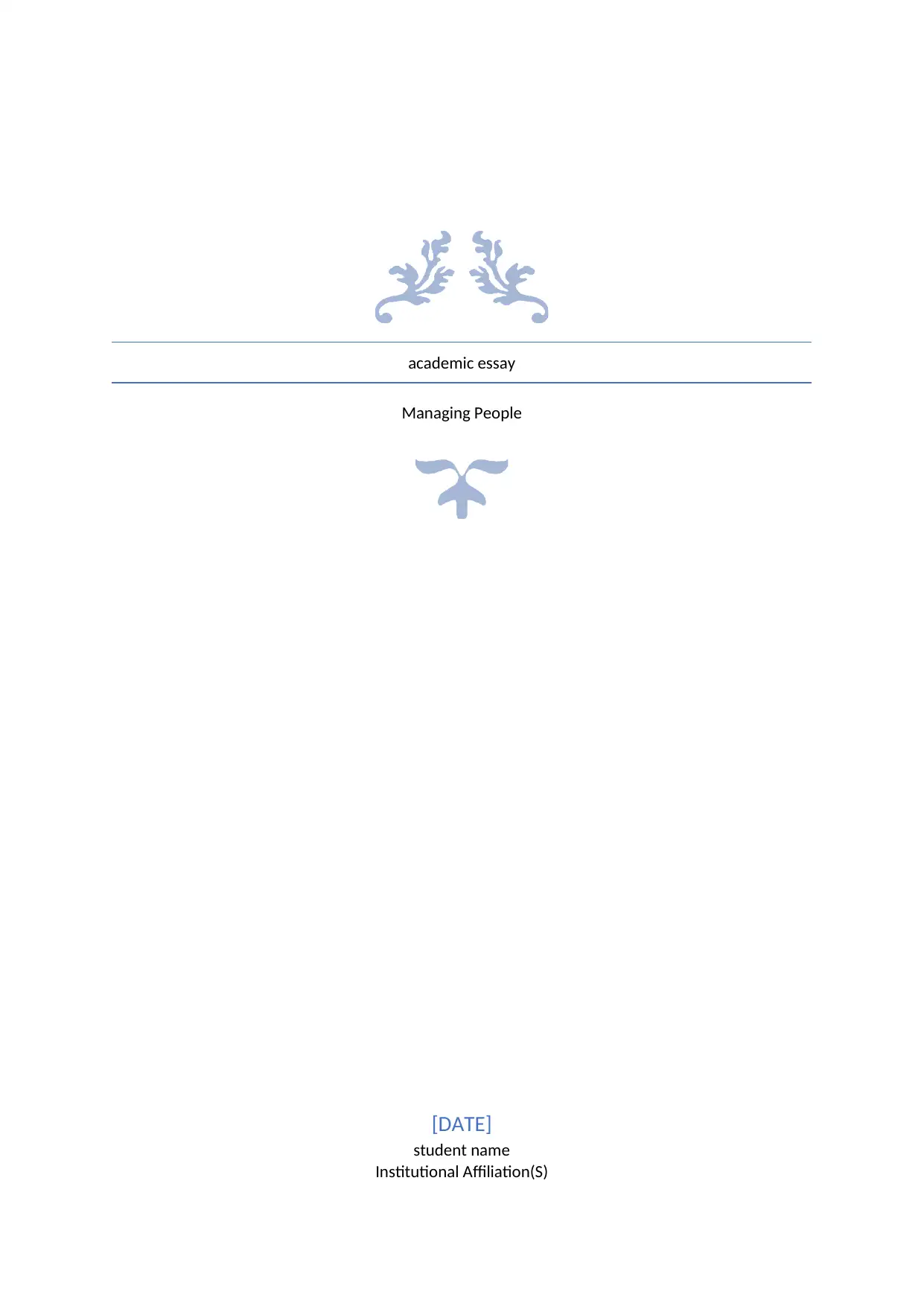
academic essay
Managing People
[DATE]
student name
Institutional Affiliation(S)
Managing People
[DATE]
student name
Institutional Affiliation(S)
Paraphrase This Document
Need a fresh take? Get an instant paraphrase of this document with our AI Paraphraser
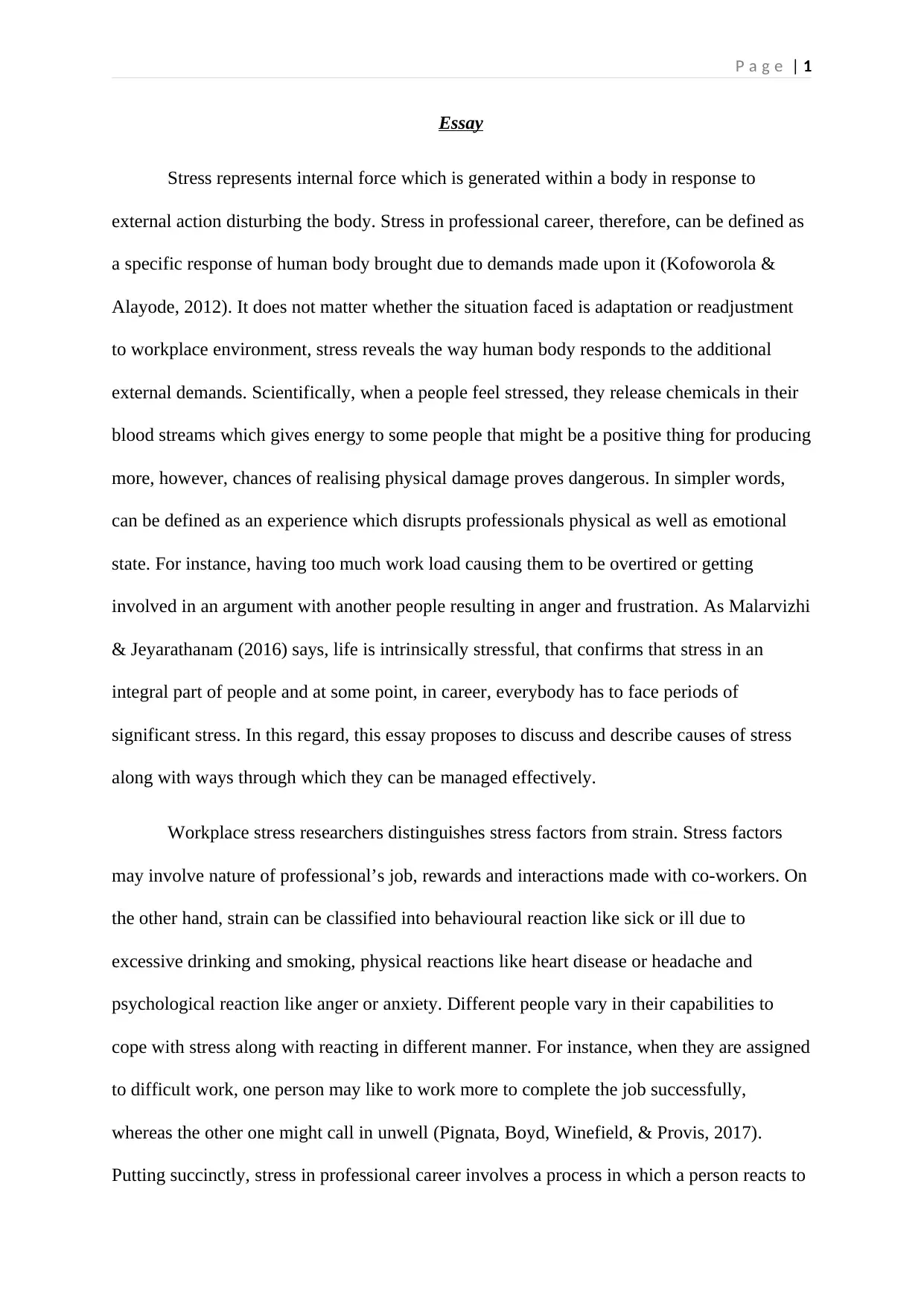
P a g e | 1
Essay
Stress represents internal force which is generated within a body in response to
external action disturbing the body. Stress in professional career, therefore, can be defined as
a specific response of human body brought due to demands made upon it (Kofoworola &
Alayode, 2012). It does not matter whether the situation faced is adaptation or readjustment
to workplace environment, stress reveals the way human body responds to the additional
external demands. Scientifically, when a people feel stressed, they release chemicals in their
blood streams which gives energy to some people that might be a positive thing for producing
more, however, chances of realising physical damage proves dangerous. In simpler words,
can be defined as an experience which disrupts professionals physical as well as emotional
state. For instance, having too much work load causing them to be overtired or getting
involved in an argument with another people resulting in anger and frustration. As Malarvizhi
& Jeyarathanam (2016) says, life is intrinsically stressful, that confirms that stress in an
integral part of people and at some point, in career, everybody has to face periods of
significant stress. In this regard, this essay proposes to discuss and describe causes of stress
along with ways through which they can be managed effectively.
Workplace stress researchers distinguishes stress factors from strain. Stress factors
may involve nature of professional’s job, rewards and interactions made with co-workers. On
the other hand, strain can be classified into behavioural reaction like sick or ill due to
excessive drinking and smoking, physical reactions like heart disease or headache and
psychological reaction like anger or anxiety. Different people vary in their capabilities to
cope with stress along with reacting in different manner. For instance, when they are assigned
to difficult work, one person may like to work more to complete the job successfully,
whereas the other one might call in unwell (Pignata, Boyd, Winefield, & Provis, 2017).
Putting succinctly, stress in professional career involves a process in which a person reacts to
Essay
Stress represents internal force which is generated within a body in response to
external action disturbing the body. Stress in professional career, therefore, can be defined as
a specific response of human body brought due to demands made upon it (Kofoworola &
Alayode, 2012). It does not matter whether the situation faced is adaptation or readjustment
to workplace environment, stress reveals the way human body responds to the additional
external demands. Scientifically, when a people feel stressed, they release chemicals in their
blood streams which gives energy to some people that might be a positive thing for producing
more, however, chances of realising physical damage proves dangerous. In simpler words,
can be defined as an experience which disrupts professionals physical as well as emotional
state. For instance, having too much work load causing them to be overtired or getting
involved in an argument with another people resulting in anger and frustration. As Malarvizhi
& Jeyarathanam (2016) says, life is intrinsically stressful, that confirms that stress in an
integral part of people and at some point, in career, everybody has to face periods of
significant stress. In this regard, this essay proposes to discuss and describe causes of stress
along with ways through which they can be managed effectively.
Workplace stress researchers distinguishes stress factors from strain. Stress factors
may involve nature of professional’s job, rewards and interactions made with co-workers. On
the other hand, strain can be classified into behavioural reaction like sick or ill due to
excessive drinking and smoking, physical reactions like heart disease or headache and
psychological reaction like anger or anxiety. Different people vary in their capabilities to
cope with stress along with reacting in different manner. For instance, when they are assigned
to difficult work, one person may like to work more to complete the job successfully,
whereas the other one might call in unwell (Pignata, Boyd, Winefield, & Provis, 2017).
Putting succinctly, stress in professional career involves a process in which a person reacts to
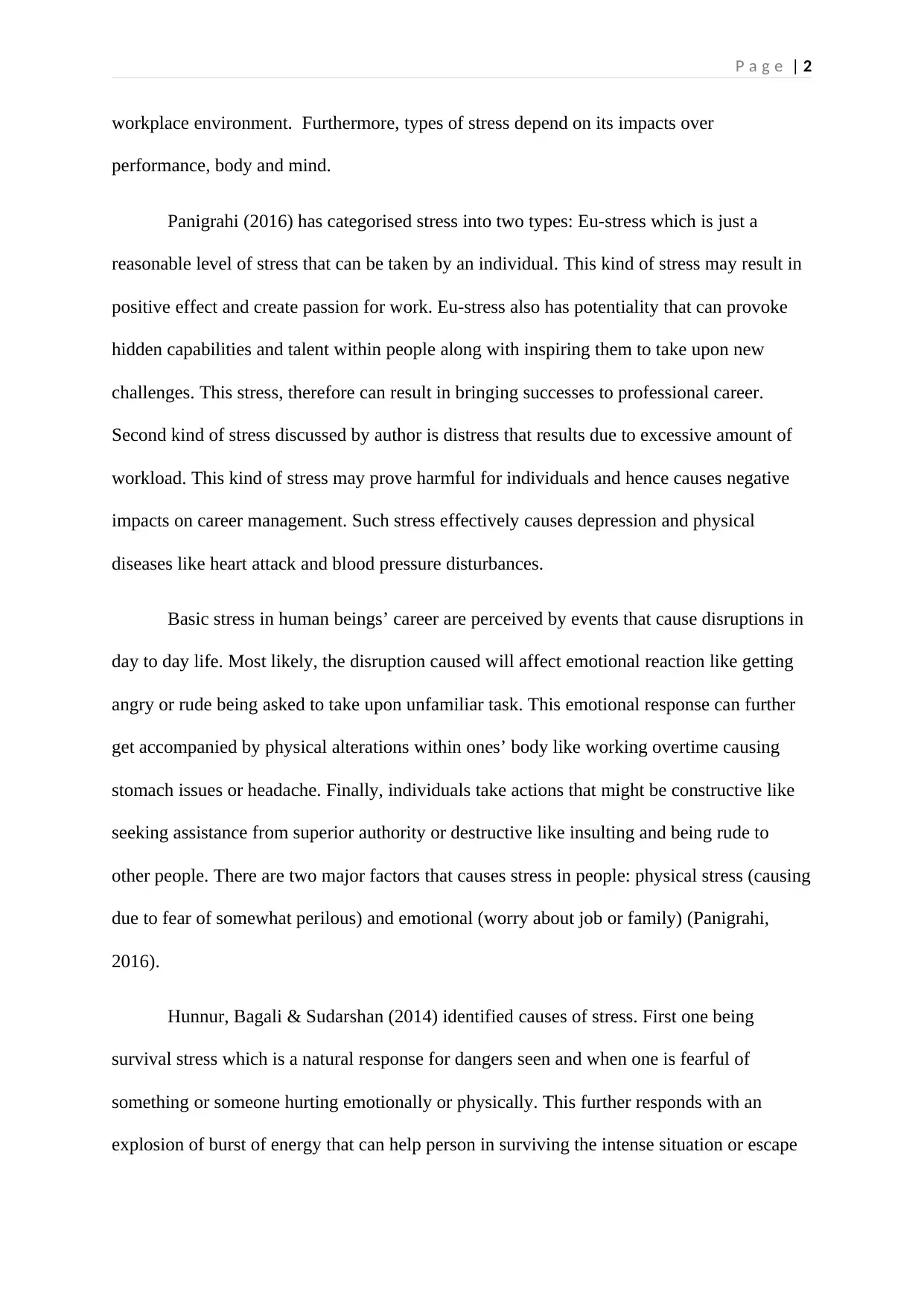
P a g e | 2
workplace environment. Furthermore, types of stress depend on its impacts over
performance, body and mind.
Panigrahi (2016) has categorised stress into two types: Eu-stress which is just a
reasonable level of stress that can be taken by an individual. This kind of stress may result in
positive effect and create passion for work. Eu-stress also has potentiality that can provoke
hidden capabilities and talent within people along with inspiring them to take upon new
challenges. This stress, therefore can result in bringing successes to professional career.
Second kind of stress discussed by author is distress that results due to excessive amount of
workload. This kind of stress may prove harmful for individuals and hence causes negative
impacts on career management. Such stress effectively causes depression and physical
diseases like heart attack and blood pressure disturbances.
Basic stress in human beings’ career are perceived by events that cause disruptions in
day to day life. Most likely, the disruption caused will affect emotional reaction like getting
angry or rude being asked to take upon unfamiliar task. This emotional response can further
get accompanied by physical alterations within ones’ body like working overtime causing
stomach issues or headache. Finally, individuals take actions that might be constructive like
seeking assistance from superior authority or destructive like insulting and being rude to
other people. There are two major factors that causes stress in people: physical stress (causing
due to fear of somewhat perilous) and emotional (worry about job or family) (Panigrahi,
2016).
Hunnur, Bagali & Sudarshan (2014) identified causes of stress. First one being
survival stress which is a natural response for dangers seen and when one is fearful of
something or someone hurting emotionally or physically. This further responds with an
explosion of burst of energy that can help person in surviving the intense situation or escape
workplace environment. Furthermore, types of stress depend on its impacts over
performance, body and mind.
Panigrahi (2016) has categorised stress into two types: Eu-stress which is just a
reasonable level of stress that can be taken by an individual. This kind of stress may result in
positive effect and create passion for work. Eu-stress also has potentiality that can provoke
hidden capabilities and talent within people along with inspiring them to take upon new
challenges. This stress, therefore can result in bringing successes to professional career.
Second kind of stress discussed by author is distress that results due to excessive amount of
workload. This kind of stress may prove harmful for individuals and hence causes negative
impacts on career management. Such stress effectively causes depression and physical
diseases like heart attack and blood pressure disturbances.
Basic stress in human beings’ career are perceived by events that cause disruptions in
day to day life. Most likely, the disruption caused will affect emotional reaction like getting
angry or rude being asked to take upon unfamiliar task. This emotional response can further
get accompanied by physical alterations within ones’ body like working overtime causing
stomach issues or headache. Finally, individuals take actions that might be constructive like
seeking assistance from superior authority or destructive like insulting and being rude to
other people. There are two major factors that causes stress in people: physical stress (causing
due to fear of somewhat perilous) and emotional (worry about job or family) (Panigrahi,
2016).
Hunnur, Bagali & Sudarshan (2014) identified causes of stress. First one being
survival stress which is a natural response for dangers seen and when one is fearful of
something or someone hurting emotionally or physically. This further responds with an
explosion of burst of energy that can help person in surviving the intense situation or escape
⊘ This is a preview!⊘
Do you want full access?
Subscribe today to unlock all pages.

Trusted by 1+ million students worldwide
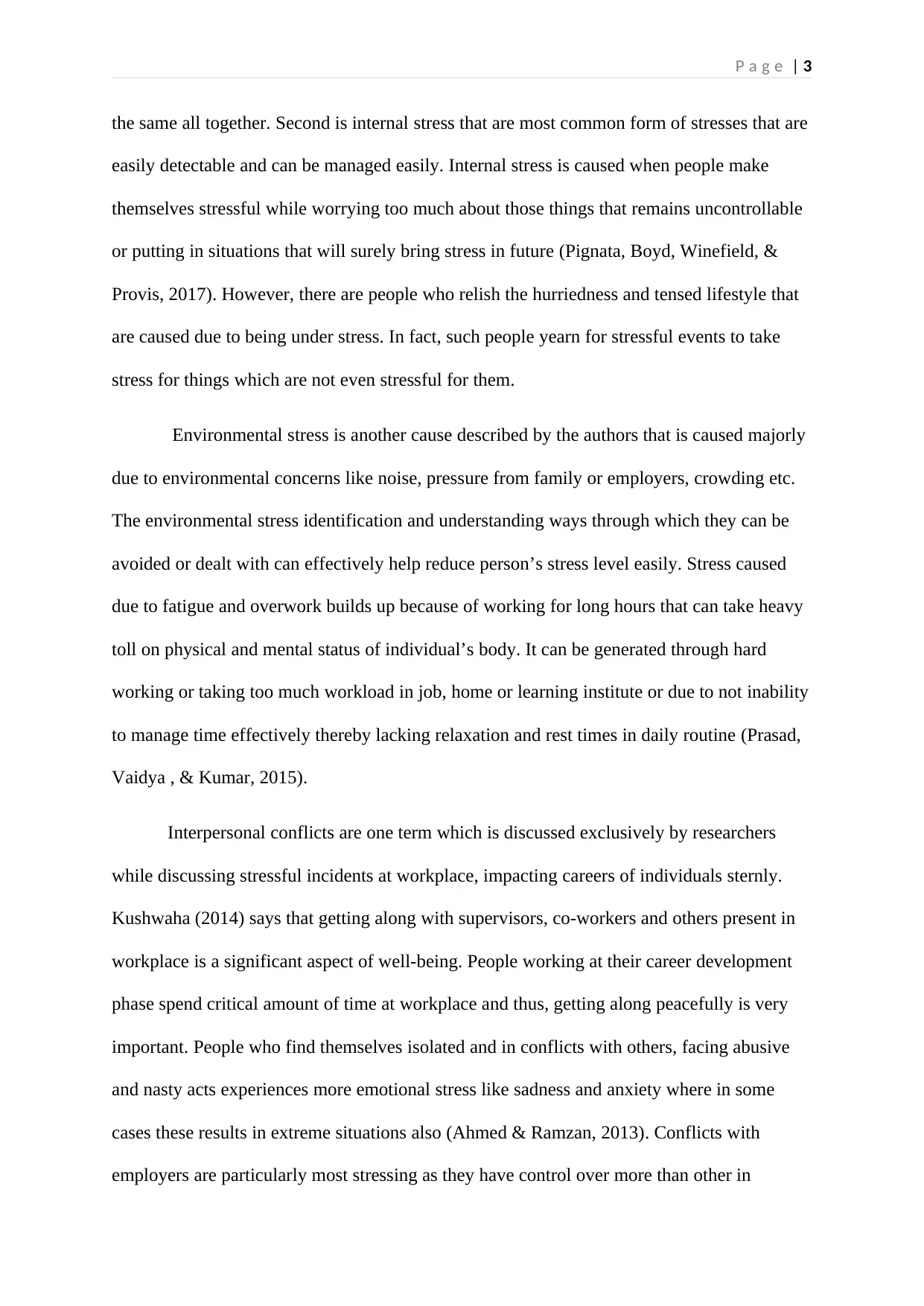
P a g e | 3
the same all together. Second is internal stress that are most common form of stresses that are
easily detectable and can be managed easily. Internal stress is caused when people make
themselves stressful while worrying too much about those things that remains uncontrollable
or putting in situations that will surely bring stress in future (Pignata, Boyd, Winefield, &
Provis, 2017). However, there are people who relish the hurriedness and tensed lifestyle that
are caused due to being under stress. In fact, such people yearn for stressful events to take
stress for things which are not even stressful for them.
Environmental stress is another cause described by the authors that is caused majorly
due to environmental concerns like noise, pressure from family or employers, crowding etc.
The environmental stress identification and understanding ways through which they can be
avoided or dealt with can effectively help reduce person’s stress level easily. Stress caused
due to fatigue and overwork builds up because of working for long hours that can take heavy
toll on physical and mental status of individual’s body. It can be generated through hard
working or taking too much workload in job, home or learning institute or due to not inability
to manage time effectively thereby lacking relaxation and rest times in daily routine (Prasad,
Vaidya , & Kumar, 2015).
Interpersonal conflicts are one term which is discussed exclusively by researchers
while discussing stressful incidents at workplace, impacting careers of individuals sternly.
Kushwaha (2014) says that getting along with supervisors, co-workers and others present in
workplace is a significant aspect of well-being. People working at their career development
phase spend critical amount of time at workplace and thus, getting along peacefully is very
important. People who find themselves isolated and in conflicts with others, facing abusive
and nasty acts experiences more emotional stress like sadness and anxiety where in some
cases these results in extreme situations also (Ahmed & Ramzan, 2013). Conflicts with
employers are particularly most stressing as they have control over more than other in
the same all together. Second is internal stress that are most common form of stresses that are
easily detectable and can be managed easily. Internal stress is caused when people make
themselves stressful while worrying too much about those things that remains uncontrollable
or putting in situations that will surely bring stress in future (Pignata, Boyd, Winefield, &
Provis, 2017). However, there are people who relish the hurriedness and tensed lifestyle that
are caused due to being under stress. In fact, such people yearn for stressful events to take
stress for things which are not even stressful for them.
Environmental stress is another cause described by the authors that is caused majorly
due to environmental concerns like noise, pressure from family or employers, crowding etc.
The environmental stress identification and understanding ways through which they can be
avoided or dealt with can effectively help reduce person’s stress level easily. Stress caused
due to fatigue and overwork builds up because of working for long hours that can take heavy
toll on physical and mental status of individual’s body. It can be generated through hard
working or taking too much workload in job, home or learning institute or due to not inability
to manage time effectively thereby lacking relaxation and rest times in daily routine (Prasad,
Vaidya , & Kumar, 2015).
Interpersonal conflicts are one term which is discussed exclusively by researchers
while discussing stressful incidents at workplace, impacting careers of individuals sternly.
Kushwaha (2014) says that getting along with supervisors, co-workers and others present in
workplace is a significant aspect of well-being. People working at their career development
phase spend critical amount of time at workplace and thus, getting along peacefully is very
important. People who find themselves isolated and in conflicts with others, facing abusive
and nasty acts experiences more emotional stress like sadness and anxiety where in some
cases these results in extreme situations also (Ahmed & Ramzan, 2013). Conflicts with
employers are particularly most stressing as they have control over more than other in
Paraphrase This Document
Need a fresh take? Get an instant paraphrase of this document with our AI Paraphraser
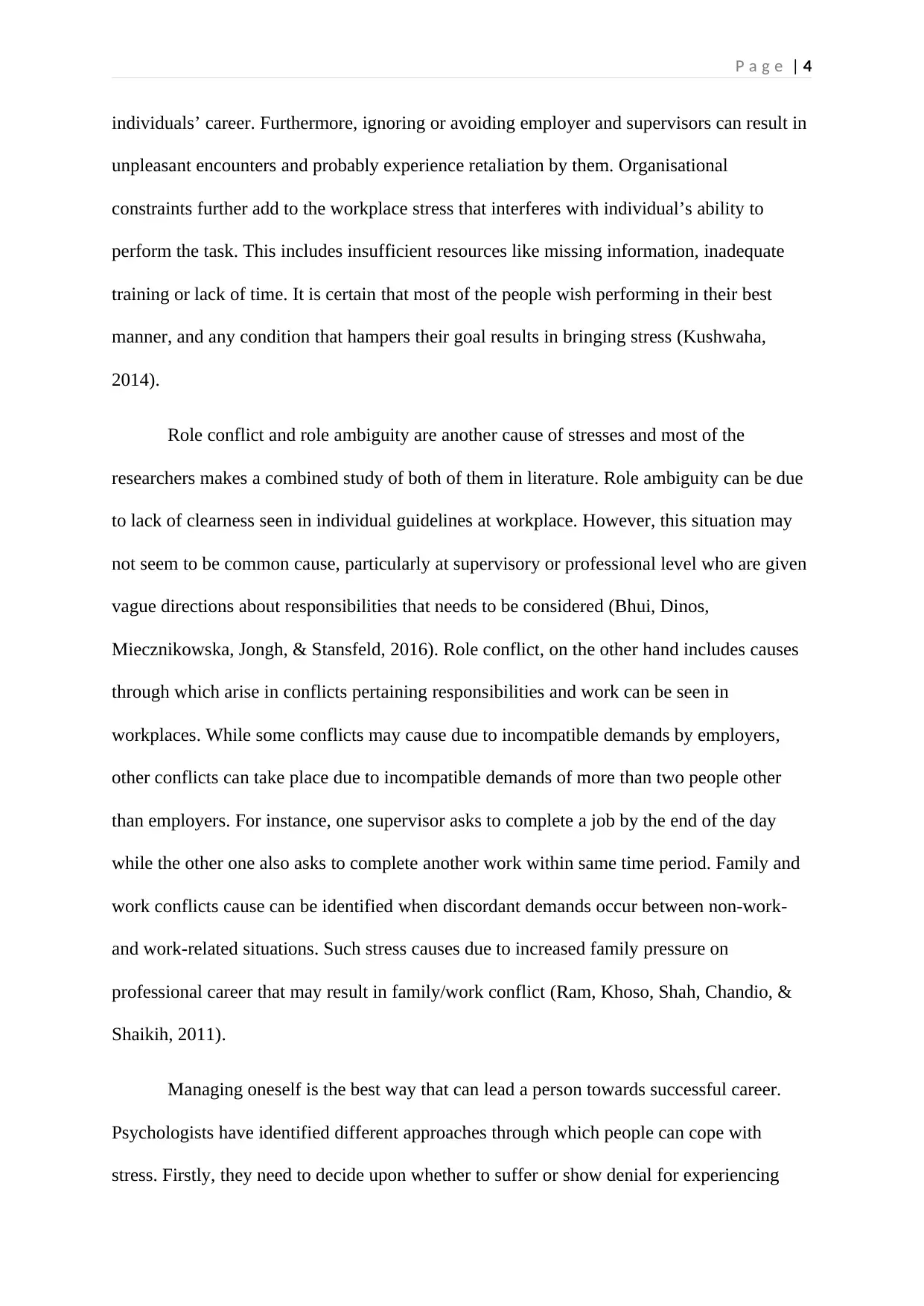
P a g e | 4
individuals’ career. Furthermore, ignoring or avoiding employer and supervisors can result in
unpleasant encounters and probably experience retaliation by them. Organisational
constraints further add to the workplace stress that interferes with individual’s ability to
perform the task. This includes insufficient resources like missing information, inadequate
training or lack of time. It is certain that most of the people wish performing in their best
manner, and any condition that hampers their goal results in bringing stress (Kushwaha,
2014).
Role conflict and role ambiguity are another cause of stresses and most of the
researchers makes a combined study of both of them in literature. Role ambiguity can be due
to lack of clearness seen in individual guidelines at workplace. However, this situation may
not seem to be common cause, particularly at supervisory or professional level who are given
vague directions about responsibilities that needs to be considered (Bhui, Dinos,
Miecznikowska, Jongh, & Stansfeld, 2016). Role conflict, on the other hand includes causes
through which arise in conflicts pertaining responsibilities and work can be seen in
workplaces. While some conflicts may cause due to incompatible demands by employers,
other conflicts can take place due to incompatible demands of more than two people other
than employers. For instance, one supervisor asks to complete a job by the end of the day
while the other one also asks to complete another work within same time period. Family and
work conflicts cause can be identified when discordant demands occur between non-work-
and work-related situations. Such stress causes due to increased family pressure on
professional career that may result in family/work conflict (Ram, Khoso, Shah, Chandio, &
Shaikih, 2011).
Managing oneself is the best way that can lead a person towards successful career.
Psychologists have identified different approaches through which people can cope with
stress. Firstly, they need to decide upon whether to suffer or show denial for experiencing
individuals’ career. Furthermore, ignoring or avoiding employer and supervisors can result in
unpleasant encounters and probably experience retaliation by them. Organisational
constraints further add to the workplace stress that interferes with individual’s ability to
perform the task. This includes insufficient resources like missing information, inadequate
training or lack of time. It is certain that most of the people wish performing in their best
manner, and any condition that hampers their goal results in bringing stress (Kushwaha,
2014).
Role conflict and role ambiguity are another cause of stresses and most of the
researchers makes a combined study of both of them in literature. Role ambiguity can be due
to lack of clearness seen in individual guidelines at workplace. However, this situation may
not seem to be common cause, particularly at supervisory or professional level who are given
vague directions about responsibilities that needs to be considered (Bhui, Dinos,
Miecznikowska, Jongh, & Stansfeld, 2016). Role conflict, on the other hand includes causes
through which arise in conflicts pertaining responsibilities and work can be seen in
workplaces. While some conflicts may cause due to incompatible demands by employers,
other conflicts can take place due to incompatible demands of more than two people other
than employers. For instance, one supervisor asks to complete a job by the end of the day
while the other one also asks to complete another work within same time period. Family and
work conflicts cause can be identified when discordant demands occur between non-work-
and work-related situations. Such stress causes due to increased family pressure on
professional career that may result in family/work conflict (Ram, Khoso, Shah, Chandio, &
Shaikih, 2011).
Managing oneself is the best way that can lead a person towards successful career.
Psychologists have identified different approaches through which people can cope with
stress. Firstly, they need to decide upon whether to suffer or show denial for experiencing
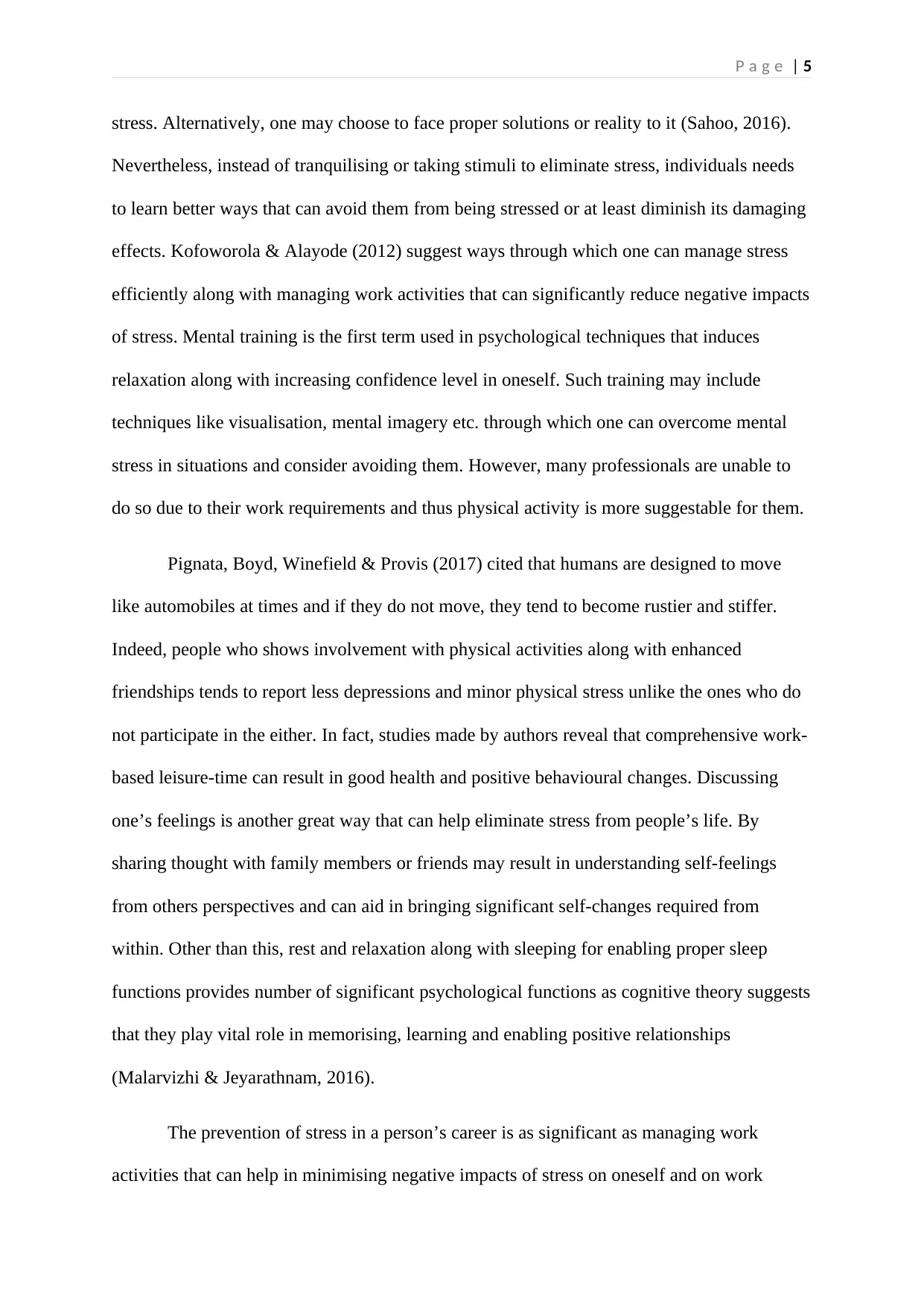
P a g e | 5
stress. Alternatively, one may choose to face proper solutions or reality to it (Sahoo, 2016).
Nevertheless, instead of tranquilising or taking stimuli to eliminate stress, individuals needs
to learn better ways that can avoid them from being stressed or at least diminish its damaging
effects. Kofoworola & Alayode (2012) suggest ways through which one can manage stress
efficiently along with managing work activities that can significantly reduce negative impacts
of stress. Mental training is the first term used in psychological techniques that induces
relaxation along with increasing confidence level in oneself. Such training may include
techniques like visualisation, mental imagery etc. through which one can overcome mental
stress in situations and consider avoiding them. However, many professionals are unable to
do so due to their work requirements and thus physical activity is more suggestable for them.
Pignata, Boyd, Winefield & Provis (2017) cited that humans are designed to move
like automobiles at times and if they do not move, they tend to become rustier and stiffer.
Indeed, people who shows involvement with physical activities along with enhanced
friendships tends to report less depressions and minor physical stress unlike the ones who do
not participate in the either. In fact, studies made by authors reveal that comprehensive work-
based leisure-time can result in good health and positive behavioural changes. Discussing
one’s feelings is another great way that can help eliminate stress from people’s life. By
sharing thought with family members or friends may result in understanding self-feelings
from others perspectives and can aid in bringing significant self-changes required from
within. Other than this, rest and relaxation along with sleeping for enabling proper sleep
functions provides number of significant psychological functions as cognitive theory suggests
that they play vital role in memorising, learning and enabling positive relationships
(Malarvizhi & Jeyarathnam, 2016).
The prevention of stress in a person’s career is as significant as managing work
activities that can help in minimising negative impacts of stress on oneself and on work
stress. Alternatively, one may choose to face proper solutions or reality to it (Sahoo, 2016).
Nevertheless, instead of tranquilising or taking stimuli to eliminate stress, individuals needs
to learn better ways that can avoid them from being stressed or at least diminish its damaging
effects. Kofoworola & Alayode (2012) suggest ways through which one can manage stress
efficiently along with managing work activities that can significantly reduce negative impacts
of stress. Mental training is the first term used in psychological techniques that induces
relaxation along with increasing confidence level in oneself. Such training may include
techniques like visualisation, mental imagery etc. through which one can overcome mental
stress in situations and consider avoiding them. However, many professionals are unable to
do so due to their work requirements and thus physical activity is more suggestable for them.
Pignata, Boyd, Winefield & Provis (2017) cited that humans are designed to move
like automobiles at times and if they do not move, they tend to become rustier and stiffer.
Indeed, people who shows involvement with physical activities along with enhanced
friendships tends to report less depressions and minor physical stress unlike the ones who do
not participate in the either. In fact, studies made by authors reveal that comprehensive work-
based leisure-time can result in good health and positive behavioural changes. Discussing
one’s feelings is another great way that can help eliminate stress from people’s life. By
sharing thought with family members or friends may result in understanding self-feelings
from others perspectives and can aid in bringing significant self-changes required from
within. Other than this, rest and relaxation along with sleeping for enabling proper sleep
functions provides number of significant psychological functions as cognitive theory suggests
that they play vital role in memorising, learning and enabling positive relationships
(Malarvizhi & Jeyarathnam, 2016).
The prevention of stress in a person’s career is as significant as managing work
activities that can help in minimising negative impacts of stress on oneself and on work
⊘ This is a preview!⊘
Do you want full access?
Subscribe today to unlock all pages.

Trusted by 1+ million students worldwide
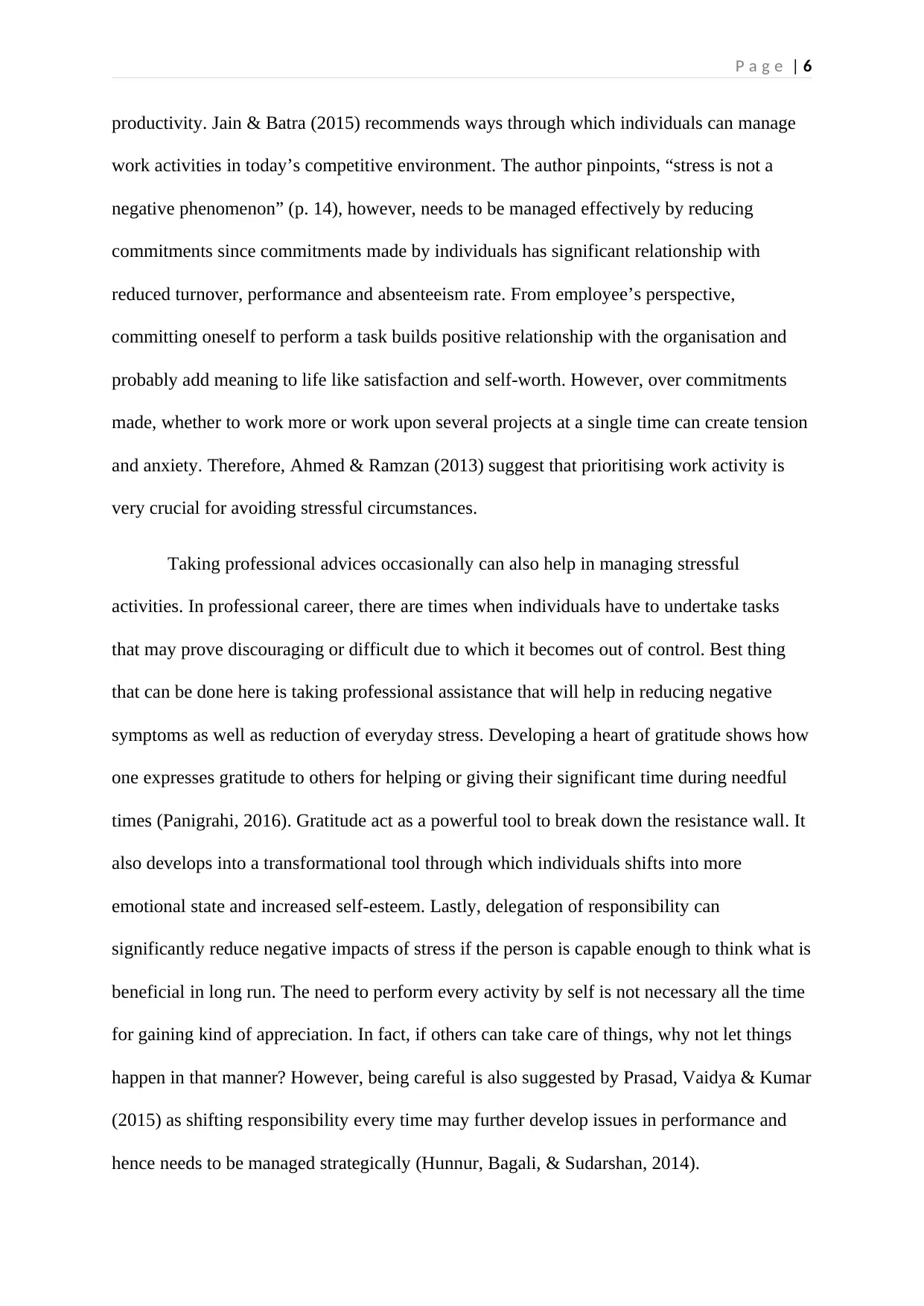
P a g e | 6
productivity. Jain & Batra (2015) recommends ways through which individuals can manage
work activities in today’s competitive environment. The author pinpoints, “stress is not a
negative phenomenon” (p. 14), however, needs to be managed effectively by reducing
commitments since commitments made by individuals has significant relationship with
reduced turnover, performance and absenteeism rate. From employee’s perspective,
committing oneself to perform a task builds positive relationship with the organisation and
probably add meaning to life like satisfaction and self-worth. However, over commitments
made, whether to work more or work upon several projects at a single time can create tension
and anxiety. Therefore, Ahmed & Ramzan (2013) suggest that prioritising work activity is
very crucial for avoiding stressful circumstances.
Taking professional advices occasionally can also help in managing stressful
activities. In professional career, there are times when individuals have to undertake tasks
that may prove discouraging or difficult due to which it becomes out of control. Best thing
that can be done here is taking professional assistance that will help in reducing negative
symptoms as well as reduction of everyday stress. Developing a heart of gratitude shows how
one expresses gratitude to others for helping or giving their significant time during needful
times (Panigrahi, 2016). Gratitude act as a powerful tool to break down the resistance wall. It
also develops into a transformational tool through which individuals shifts into more
emotional state and increased self-esteem. Lastly, delegation of responsibility can
significantly reduce negative impacts of stress if the person is capable enough to think what is
beneficial in long run. The need to perform every activity by self is not necessary all the time
for gaining kind of appreciation. In fact, if others can take care of things, why not let things
happen in that manner? However, being careful is also suggested by Prasad, Vaidya & Kumar
(2015) as shifting responsibility every time may further develop issues in performance and
hence needs to be managed strategically (Hunnur, Bagali, & Sudarshan, 2014).
productivity. Jain & Batra (2015) recommends ways through which individuals can manage
work activities in today’s competitive environment. The author pinpoints, “stress is not a
negative phenomenon” (p. 14), however, needs to be managed effectively by reducing
commitments since commitments made by individuals has significant relationship with
reduced turnover, performance and absenteeism rate. From employee’s perspective,
committing oneself to perform a task builds positive relationship with the organisation and
probably add meaning to life like satisfaction and self-worth. However, over commitments
made, whether to work more or work upon several projects at a single time can create tension
and anxiety. Therefore, Ahmed & Ramzan (2013) suggest that prioritising work activity is
very crucial for avoiding stressful circumstances.
Taking professional advices occasionally can also help in managing stressful
activities. In professional career, there are times when individuals have to undertake tasks
that may prove discouraging or difficult due to which it becomes out of control. Best thing
that can be done here is taking professional assistance that will help in reducing negative
symptoms as well as reduction of everyday stress. Developing a heart of gratitude shows how
one expresses gratitude to others for helping or giving their significant time during needful
times (Panigrahi, 2016). Gratitude act as a powerful tool to break down the resistance wall. It
also develops into a transformational tool through which individuals shifts into more
emotional state and increased self-esteem. Lastly, delegation of responsibility can
significantly reduce negative impacts of stress if the person is capable enough to think what is
beneficial in long run. The need to perform every activity by self is not necessary all the time
for gaining kind of appreciation. In fact, if others can take care of things, why not let things
happen in that manner? However, being careful is also suggested by Prasad, Vaidya & Kumar
(2015) as shifting responsibility every time may further develop issues in performance and
hence needs to be managed strategically (Hunnur, Bagali, & Sudarshan, 2014).
Paraphrase This Document
Need a fresh take? Get an instant paraphrase of this document with our AI Paraphraser
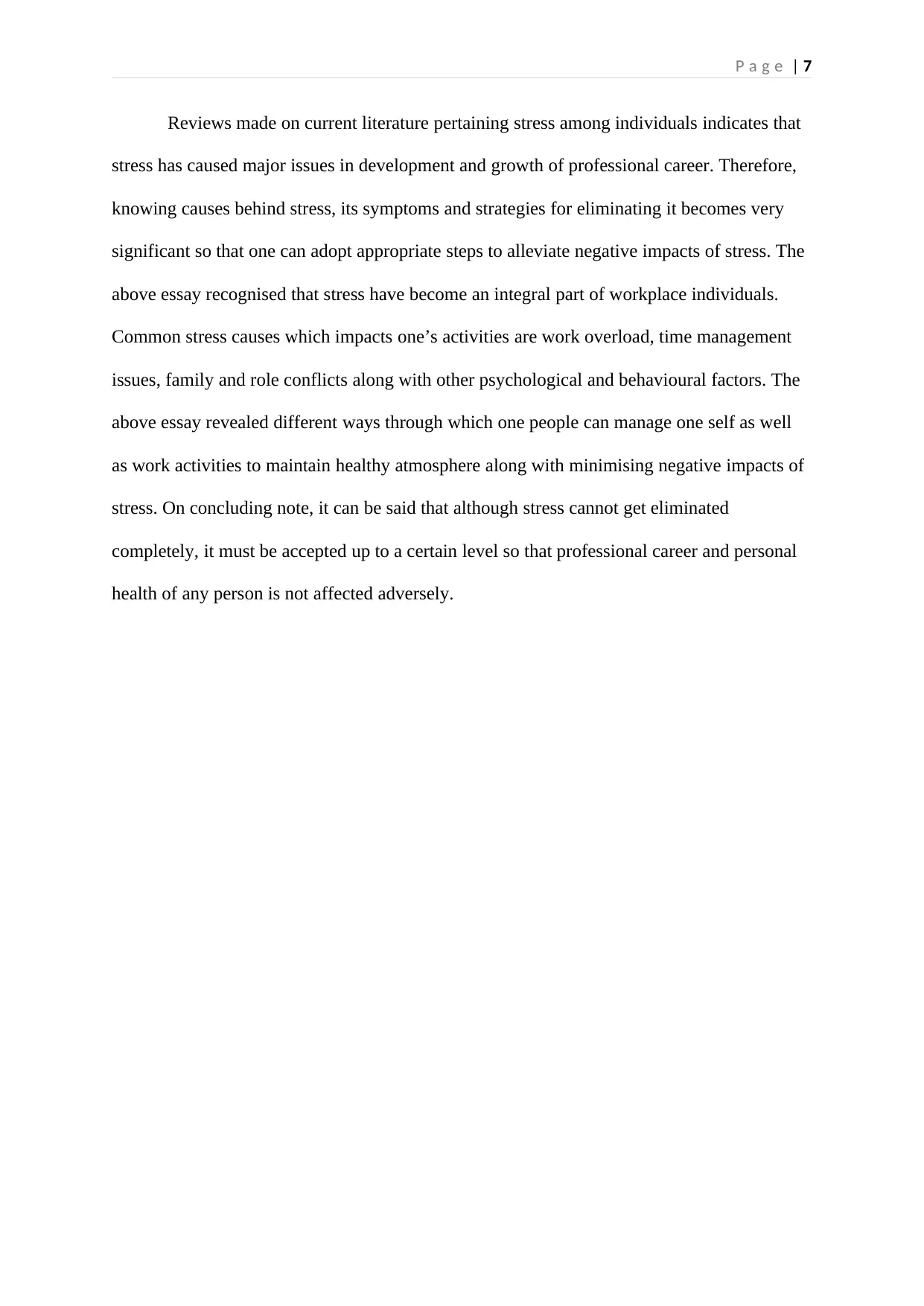
P a g e | 7
Reviews made on current literature pertaining stress among individuals indicates that
stress has caused major issues in development and growth of professional career. Therefore,
knowing causes behind stress, its symptoms and strategies for eliminating it becomes very
significant so that one can adopt appropriate steps to alleviate negative impacts of stress. The
above essay recognised that stress have become an integral part of workplace individuals.
Common stress causes which impacts one’s activities are work overload, time management
issues, family and role conflicts along with other psychological and behavioural factors. The
above essay revealed different ways through which one people can manage one self as well
as work activities to maintain healthy atmosphere along with minimising negative impacts of
stress. On concluding note, it can be said that although stress cannot get eliminated
completely, it must be accepted up to a certain level so that professional career and personal
health of any person is not affected adversely.
Reviews made on current literature pertaining stress among individuals indicates that
stress has caused major issues in development and growth of professional career. Therefore,
knowing causes behind stress, its symptoms and strategies for eliminating it becomes very
significant so that one can adopt appropriate steps to alleviate negative impacts of stress. The
above essay recognised that stress have become an integral part of workplace individuals.
Common stress causes which impacts one’s activities are work overload, time management
issues, family and role conflicts along with other psychological and behavioural factors. The
above essay revealed different ways through which one people can manage one self as well
as work activities to maintain healthy atmosphere along with minimising negative impacts of
stress. On concluding note, it can be said that although stress cannot get eliminated
completely, it must be accepted up to a certain level so that professional career and personal
health of any person is not affected adversely.
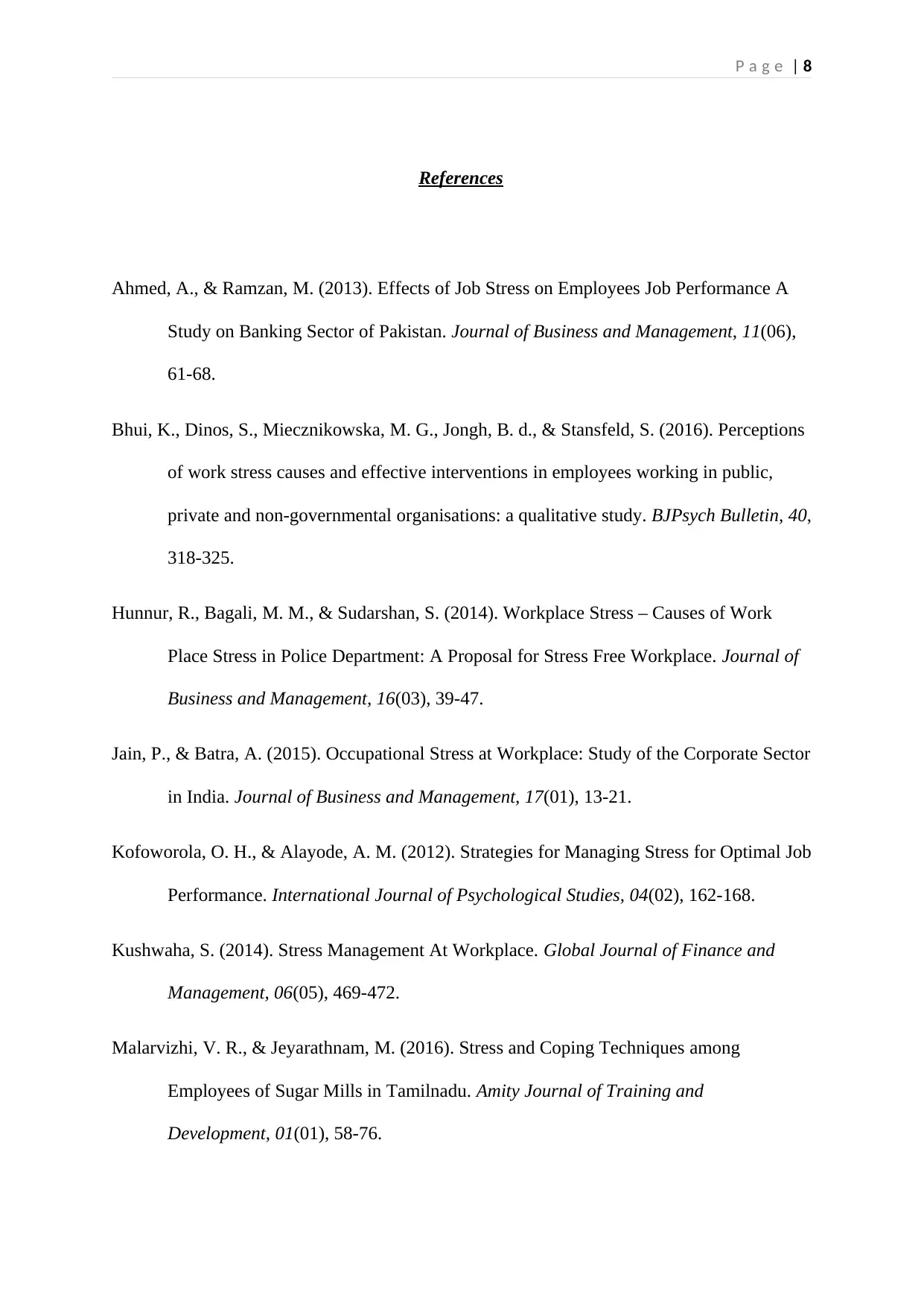
P a g e | 8
References
Ahmed, A., & Ramzan, M. (2013). Effects of Job Stress on Employees Job Performance A
Study on Banking Sector of Pakistan. Journal of Business and Management, 11(06),
61-68.
Bhui, K., Dinos, S., Miecznikowska, M. G., Jongh, B. d., & Stansfeld, S. (2016). Perceptions
of work stress causes and effective interventions in employees working in public,
private and non-governmental organisations: a qualitative study. BJPsych Bulletin, 40,
318-325.
Hunnur, R., Bagali, M. M., & Sudarshan, S. (2014). Workplace Stress – Causes of Work
Place Stress in Police Department: A Proposal for Stress Free Workplace. Journal of
Business and Management, 16(03), 39-47.
Jain, P., & Batra, A. (2015). Occupational Stress at Workplace: Study of the Corporate Sector
in India. Journal of Business and Management, 17(01), 13-21.
Kofoworola, O. H., & Alayode, A. M. (2012). Strategies for Managing Stress for Optimal Job
Performance. International Journal of Psychological Studies, 04(02), 162-168.
Kushwaha, S. (2014). Stress Management At Workplace. Global Journal of Finance and
Management, 06(05), 469-472.
Malarvizhi, V. R., & Jeyarathnam, M. (2016). Stress and Coping Techniques among
Employees of Sugar Mills in Tamilnadu. Amity Journal of Training and
Development, 01(01), 58-76.
References
Ahmed, A., & Ramzan, M. (2013). Effects of Job Stress on Employees Job Performance A
Study on Banking Sector of Pakistan. Journal of Business and Management, 11(06),
61-68.
Bhui, K., Dinos, S., Miecznikowska, M. G., Jongh, B. d., & Stansfeld, S. (2016). Perceptions
of work stress causes and effective interventions in employees working in public,
private and non-governmental organisations: a qualitative study. BJPsych Bulletin, 40,
318-325.
Hunnur, R., Bagali, M. M., & Sudarshan, S. (2014). Workplace Stress – Causes of Work
Place Stress in Police Department: A Proposal for Stress Free Workplace. Journal of
Business and Management, 16(03), 39-47.
Jain, P., & Batra, A. (2015). Occupational Stress at Workplace: Study of the Corporate Sector
in India. Journal of Business and Management, 17(01), 13-21.
Kofoworola, O. H., & Alayode, A. M. (2012). Strategies for Managing Stress for Optimal Job
Performance. International Journal of Psychological Studies, 04(02), 162-168.
Kushwaha, S. (2014). Stress Management At Workplace. Global Journal of Finance and
Management, 06(05), 469-472.
Malarvizhi, V. R., & Jeyarathnam, M. (2016). Stress and Coping Techniques among
Employees of Sugar Mills in Tamilnadu. Amity Journal of Training and
Development, 01(01), 58-76.
⊘ This is a preview!⊘
Do you want full access?
Subscribe today to unlock all pages.

Trusted by 1+ million students worldwide
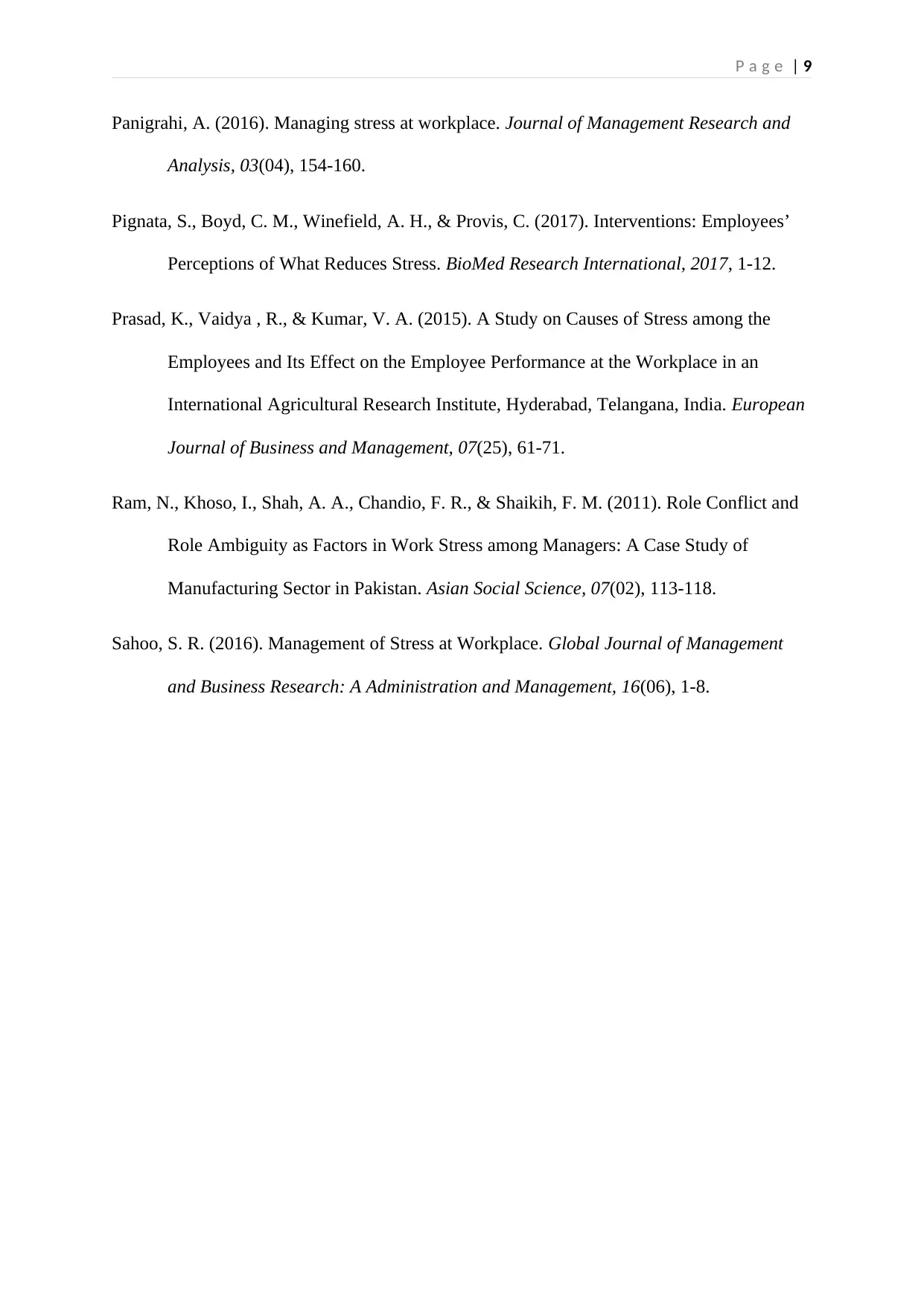
P a g e | 9
Panigrahi, A. (2016). Managing stress at workplace. Journal of Management Research and
Analysis, 03(04), 154-160.
Pignata, S., Boyd, C. M., Winefield, A. H., & Provis, C. (2017). Interventions: Employees’
Perceptions of What Reduces Stress. BioMed Research International, 2017, 1-12.
Prasad, K., Vaidya , R., & Kumar, V. A. (2015). A Study on Causes of Stress among the
Employees and Its Effect on the Employee Performance at the Workplace in an
International Agricultural Research Institute, Hyderabad, Telangana, India. European
Journal of Business and Management, 07(25), 61-71.
Ram, N., Khoso, I., Shah, A. A., Chandio, F. R., & Shaikih, F. M. (2011). Role Conflict and
Role Ambiguity as Factors in Work Stress among Managers: A Case Study of
Manufacturing Sector in Pakistan. Asian Social Science, 07(02), 113-118.
Sahoo, S. R. (2016). Management of Stress at Workplace. Global Journal of Management
and Business Research: A Administration and Management, 16(06), 1-8.
Panigrahi, A. (2016). Managing stress at workplace. Journal of Management Research and
Analysis, 03(04), 154-160.
Pignata, S., Boyd, C. M., Winefield, A. H., & Provis, C. (2017). Interventions: Employees’
Perceptions of What Reduces Stress. BioMed Research International, 2017, 1-12.
Prasad, K., Vaidya , R., & Kumar, V. A. (2015). A Study on Causes of Stress among the
Employees and Its Effect on the Employee Performance at the Workplace in an
International Agricultural Research Institute, Hyderabad, Telangana, India. European
Journal of Business and Management, 07(25), 61-71.
Ram, N., Khoso, I., Shah, A. A., Chandio, F. R., & Shaikih, F. M. (2011). Role Conflict and
Role Ambiguity as Factors in Work Stress among Managers: A Case Study of
Manufacturing Sector in Pakistan. Asian Social Science, 07(02), 113-118.
Sahoo, S. R. (2016). Management of Stress at Workplace. Global Journal of Management
and Business Research: A Administration and Management, 16(06), 1-8.
1 out of 10
Related Documents
Your All-in-One AI-Powered Toolkit for Academic Success.
+13062052269
info@desklib.com
Available 24*7 on WhatsApp / Email
![[object Object]](/_next/static/media/star-bottom.7253800d.svg)
Unlock your academic potential
Copyright © 2020–2025 A2Z Services. All Rights Reserved. Developed and managed by ZUCOL.




